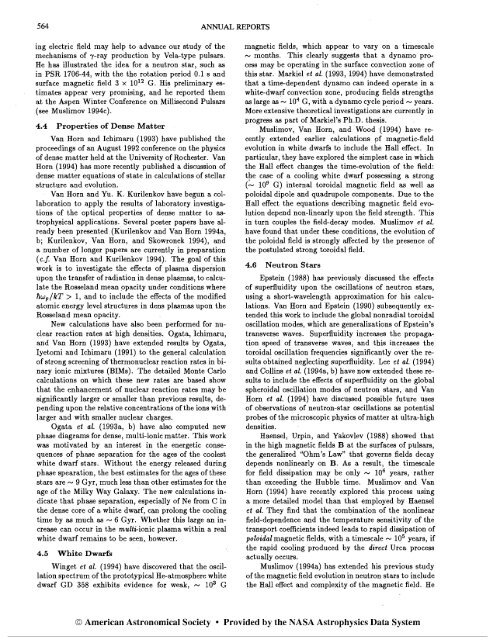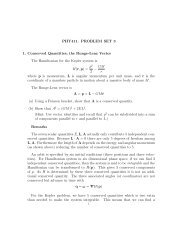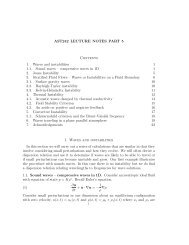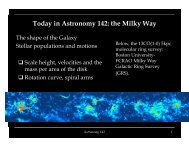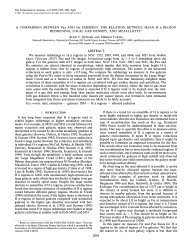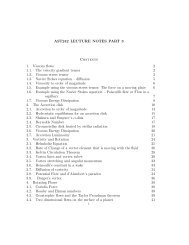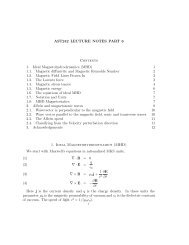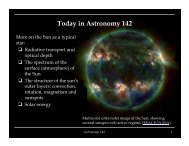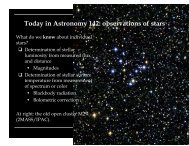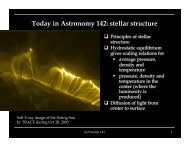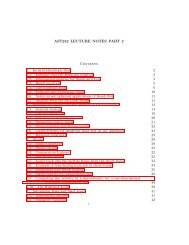University of Rochester C. E. K. Mees Observatory - Astro Pas ...
University of Rochester C. E. K. Mees Observatory - Astro Pas ...
University of Rochester C. E. K. Mees Observatory - Astro Pas ...
Create successful ePaper yourself
Turn your PDF publications into a flip-book with our unique Google optimized e-Paper software.
564 ANNUAL REPORTSing electric field may help to advance our study <strong>of</strong> themechanisms <strong>of</strong> 7-ray production by Vela-type pulsars.He has illustrated the idea for a neutron star, such asin PSR 1706-44, with the the rotation period 0.1 s andsurface magnetic field 3 x 1012 G. His preliminary estimatesappear very promising, and he reported themat the Aspen Winter Conference on Millisecond Pulsars(see Muslimov 1994~).4.4 Properties <strong>of</strong> Dense MatterVan Horn and Ichimaru (1993) have published theproceedings <strong>of</strong> an August 1992 conference on the physics<strong>of</strong> dense matter held at the <strong>University</strong> <strong>of</strong> <strong>Rochester</strong>. VanHorn (1994) has more recently published a discussion <strong>of</strong>dense matter equations <strong>of</strong> state in calculations <strong>of</strong> stellarstructure and evolution.Van Horn and Yu. K. Kurilenkov have begun a collaborationto apply the results <strong>of</strong> laboratory investigations<strong>of</strong> the optical properties <strong>of</strong> dense matter to astrophysicalapplications. Several poster papers have alreadybeen presented (Kurilenkov and Van Horn 1994a,b; Kurilenkov, Van Horn, and Skowronek 1994), anda number <strong>of</strong> longer papers are currently in preparation(c.f. Van Horn and Kurilenkov 1994). The goal <strong>of</strong> thiswork is to investigate the effects <strong>of</strong> plasma dispersionupon the transfer <strong>of</strong> radiation in dense plasmas, to calculatethe Rosseland mean opacity under conditions whereliwp/kT > 1, and to include the effects <strong>of</strong> the modifiedatomic energy level structures in dens plasmas upon theRosseland mean opacity.New calculations have also been performed for nuclearreaction rates at high densities. Ogata, Ichimaru,and Van Horn (1993) have extended results by Ogata,Iyetomi and Ichimaru (1991) to the general calculation<strong>of</strong> strong screening <strong>of</strong> thermonuclear reaction rates in binaryionic mixtures (BIMs). The detailed Monte Carloca1culations on which these new rates are based showthat the enhancement <strong>of</strong> nuclear reaction rates may besignificantly larger or smaller than previous results, dependingupon the relative concentrations <strong>of</strong> the ions withlarger and with smaller nuclear charges.Ogata et al. (1993a, b) have also computed newphase diagrams for dense, multi-ionic matter. This workwas motivated by an interest in the energetic consequences<strong>of</strong> phase separation for the ages <strong>of</strong> the coolestwhite dwarf stars. Without the energy released duringphase spearation, the best estimates for the ages <strong>of</strong> thesestars are N 9 Gyr, much less than other estimates for theage <strong>of</strong> the Milky Way Galaxy. The new calculations indicatethat phase separation, especially <strong>of</strong> Ne from C inthe dense core <strong>of</strong> a white dwarf, can prolong the coolingtime by as much as - 6 Gyr. Whether this large an increasecan occur in the multa-ionic plasma within a realwhite dwarf remains to be seen, however.4.5 White DwarfsWinget et al. (1994) have discovered that the oscillationspectrum <strong>of</strong> the prototypical He-atmosphere whitedwarf GD 358 exhibits evidence for weak, - lo3 Gmagnetic fields, which appear to vary on a timescaleN months. This clearly suggests that a dynamo processmay be operating in the surface convection zone <strong>of</strong>this star. Markiel et a!. (1993, 1994) have demonstratedthat a time-dependent dynamo can indeed operate in awhite-dwarf convection zone, producing fields strengthsas large as - lo4 G, with a dynamo cycle period - years.More extensive theoretical investigations are currently inprogress as part <strong>of</strong> Markiel's Ph.D. thesis.Muslimov, Van Horn, and Wood (1994) have recentlyextended earlier calculations <strong>of</strong> magnetic-fieldevolution in white dwarfs to include the Hall effect. Inparticular, they have explored the simplest case in whichthe Hall effect changes the time-evolution <strong>of</strong> the field:the case <strong>of</strong> a cooling white dwarf possessing a strong(- lo9 G) internal toroidal magnetic field as well aspoloidal dipole and quadrupole components. Due to theHall effect the equations describing magnetic field evolutiondepend non-linearly upon the field strength. Thisin turn couples the field-decay modes. Muslimov et a1.have found that under these conditions, the evolution <strong>of</strong>the poloidal field is strongly affected by the presence <strong>of</strong>the postulated strong toroidal field.4.6 Neutron StarsEpstein (1988) has previously discussed the effects<strong>of</strong> superfluidity upon the oscillations <strong>of</strong> neutron stars,using a short-wavelength approximation for his calculations.Van Horn and Epstein (1990) subsequently extendedthis work to include the global nonradial toroidaloscillation modes, which are generalizations <strong>of</strong> Epstein'stransverse waves. Superfluidity increases the propagationspeed <strong>of</strong> transverse waves, and this increases thetoroidal oscillation frequencies significantly over the resultsobtained neglecting superfluidity. Lee et al. (1994)and Collins et al. (1994a, b) have now extended these resultsto include the effects <strong>of</strong> superfluidity on the globalspheroidal oscillation modes <strong>of</strong> neutron stars, and VanHorn et al. (1994) have discussed possible future uses<strong>of</strong> observations <strong>of</strong> neutron-star oscillations as potentialprobes <strong>of</strong> the microscopic physics <strong>of</strong> matter at ultra-highdensities.Haensel, Urpin, and Yakovlev (1988) showed thatin the high magnetic fields B at the surfaces <strong>of</strong> pulsars,the generalized "Ohm's Law" that governs fields decaydepends nonlinearly on B. As a result, the timescalefor field dissipation may be only - lo6 years, ratherthan exceeding the Hubble time. Muslimov and VanHorn (1994) have recently explored this process usinga more detailed model than that employed by Haenselet al. They find that the combination <strong>of</strong> the nonlinearfield-dependence and the temperature sensitivity <strong>of</strong> thetransport coefficients indeed leads to rapid dissipation <strong>of</strong>poloidal magnetic fields, with a timescale - lo5 years, ifthe rapid cooling produced by the direct Urca processactually occurs.Muslimov (1994a) has extended his previous study<strong>of</strong> the magnetic field evolution in neutron stars to includethe Hall effect and complexity <strong>of</strong> the magnetic field. HeO American <strong>Astro</strong>nomical SocietyProvided by the NASA <strong>Astro</strong>physics Data System


